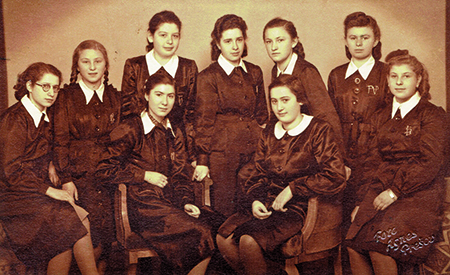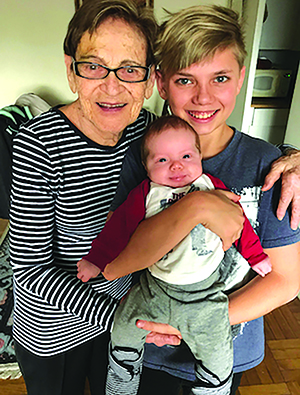Being Jewish
The First Official, All-Female Jewish Transport to Auschwitz

On March 20, 1942, Slovakia ordered unmarried Jewish women ages 16 to 32 to register for government work. Many of them, even though they had never spent a night away from their homes, eagerly volunteered for what they thought would be three months of work at a shoe or munitions factory. Impeccably dressed and coiffed, dragging suitcases filled with handmade clothing and kosher food packed by their mothers, they boarded a passenger train.
What they didn’t know was that Slovakia, an Axis partner with Germany, had, under the framework of the Final Solution, paid the Nazis to take these girls for slave labor. As their parents and siblings waved goodbye, none of them thought it might be for the last time. Certainly, no one realized they were bound for Auschwitz, which, until early 1942, had been a concentration camp and detention center for prisoners of war, Polish intellectuals, communists and resistance fighters. A train with 40 Jewish men, arrested for petty thievery, arrived in February and were killed immediately with Zyklon B gas.
There were no women, at all.
“We thought we were going on an adventure,” Margaret Becker Rosenberg recalled in her USC Shoah Foundation testimony. At 18, Margaret had one thing on her mind. “I wanted to go with my friends.”
Accompanying Margaret was her neighbor and classmate Edith Friedman Grosman, who is now 95 years old and one of the few living survivors of this first “official” Jewish transport to Auschwitz—official because it was mandated by SS commander Heinrich Himmler, under the authority of Adolph Eichmann as well as under the Reich Security Central Office.
Edith and I met in 2017 in Slovakia, and she has worked with me on my book 999: The Extraordinary Young Women of the First Official Jewish Transport to Auschwitz. This year, the 75th anniversary of the liberation of Auschwitz, we are collaborating on a companion documentary about her story and that women’s transport from Slovakia.
Edith was 17 and a slip of a girl who hid in the shadow of her elder sister, Lea, as they and 200 other young women departed their hometown of Humenne to go to “work.” Feeling very grown up at having just registered as “contract volunteers”—the euphemism the government used for slave labor—they all sang the Slovak national anthem when the High Tatra mountains appeared outside their train windows. A few hours later, they disembarked into an empty army barrack in Poprad where they were held for five days, waiting until a total of 999 young women were collected from neighboring towns before they were all transported to Poland, where they arrived March 26.
More than two decades before I befriended Edith, I was drawn to the story of this transport to Auschwitz after meeting Rena Kornreich Gelissen. Rena was one of the few Poles on that transport; she survived the camp along with her sister, Danka, who arrived on the second transport. After the war they immigrated to the United States.
Even though Rena and I spent many months writing her story (Rena’s Promise: A Story of Sisters in Auschwitz, revised in 2015), there were memories that she did not share. For instance, she never revealed that mass outdoor selections of women were carried out in the nude, no matter the weather. I learned that from other testimonies at the USC Shoah Foundation.
When I began this investigative journey, I was surprised that more historians didn’t mention this Jewish transport made up entirely of young women. They were forced to perform hard labor, including demolishing buildings and clearing roads and ditches of snow with their bare hands.
Five months after their arrival in Auschwitz, in August 1942, the women were moved to the newly built section of Auschwitz, called Birkenau (or Auschwitz II), and “the death camp began,” Edith said. Over the next two years, Birkenau would expand to the size of 319 football fields and become a killing center with eight gas chambers, four crematoria and 46 ovens where about 1.1 million Jews, Roma and other people considered undesirable by the Third Reich would be murdered.

One of the astonishing facts about surviving the death camp was that as girls lost sisters, friends become family. “You couldn’t survive Auschwitz on your own,” said Edith, who married after the war and now lives in Toronto. “You needed someone watching over you.” When Edith’s own sister, Lea, who was ill with typhus, was taken to the gas chamber in a mass killing on December 5, 1942—a Shabbat Hanukkah—Edith gave up all hope. Her friend Elza instantly became her lager (camp) sister and helped Edith stay alive.
Survivors—including Rena, Edith and Rudolf Vrba in his memoir, I Escaped Auschwitz—have attested that 10,000 women were killed on that Shabbat Hanukkah. That number was a shocking revelation to me, because it contradicts The Auschwitz Chronicle, archival material that notes the SS report of 2,000 female inmates being killed.
Many of the women found their faith in God destroyed while in the camps, but Bertha Berkowitz Lautman, who was born into a Hasidic family, clung to her beliefs, even fasting on Yom Kippur each year. In April 1943, Bertha and some others decided to organize a secret Passover seder. One of her blockmates, who worked sorting the clothes of newly arrived Jews, gathered enough raisins out of their pockets to make raisin wine; another one working in the kitchen smuggled out cooked potatoes. There was no matzah, but for starving women to eat a potato—that was miracle enough. “You play with your life to do something like this,” Bertha said in a 1981 documentary, Tomorrow Came Much Later: A Journey of Conscience, “but it was worth it. In the darkness, we prayed for freedom.”
But freedom was a long way off. In mid-January 1945, as the Soviet forces approached the Auschwitz complex, the SS began evacuating prisoners. Over 12,000 female prisoners (sent separately from the male prisoners) were forced on a death march to various other camps in the middle of a blizzard. When the Russian army finally liberated Auschwitz on January 27, they found about 6,000 ill prisoners—4,000 of them women.
The death march is among the worst memories for survivors. Edith, who had contracted tuberculosis of the bone in her knee, walked with a painful limp. Watching those who had endured nearly three years in the camp succumb to cold or starvation threatened to break even the most stalwart woman. “How did I survive this thing?” Edith still wonders.
I believe part of the answer lies in sisterhood. Whether in the death camp or on the death march, when someone sat down and gave up, others would haul the exhausted friend back to her feet and help her walk until her strength returned. Many of these women created a survivors’ sorority, and that was key.
As survivors age, we must remind the world of what horrors human beings are capable of. But it is equally important to remember our humanity. It was not through isolation that these women survived Auschwitz—the exact number is unknown but may be about 75 to 80—but through courage and human connection. That is a lesson none of us can afford to forget.
Heather Dune Macadam is the author of 999: The Extraordinary Young Women of the First Official Jewish Transport to Auschwitz (Citadel Press).










 Facebook
Facebook Instagram
Instagram Twitter
Twitter
Jill Pargeter says
May the atrocities of past wars NEVER be repeated.